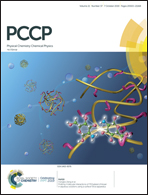Switching of the reaction enthalpy from exothermic to endothermic for decomposition of H2CO3 under confinement†
Abstract
Various size fullerenes (C60, C70 and C84) have been used as a means of confinement to study the decomposition reaction of carbonic acid alone as well as in the presence of a single water molecule in a confined environment. Quantum chemical calculations reveal that as the effect of confinement increases by reducing the size of the fullerene cage, the bare reaction switches from exothermic to endothermic gradually. As a result, the equilibrium of the reaction shifts toward the reactant side, which suggests that the decomposition of carbonic acid becomes thermodynamically disfavored under confinement. In the presence of a single water molecule inside the C84 fullerene cage, the barrier height of unimolecular decomposition is found to be decreased by ∼2.1 kcal mol−1 as compared to the gas phase reaction. Besides the effect of confinement, we have also studied the pressure dependency of and the effect of an external electric field on the title reaction. By parameterizing the behavior of the system inside the fullerene in terms of pressure, we have shown that the fullerene cage can act as a high pressure container for this reaction. Our investigations also reveal that, similar to confinement, an external electric field could also switch the reaction from exothermic to endothermic in nature.



 Please wait while we load your content...
Please wait while we load your content...